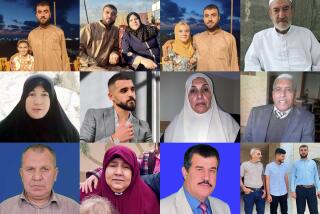Heroes’ Burial for Sons of Hussein
- Share via
BAGHDAD — Saddam Hussein’s two older sons and a grandson were buried as martyrs Saturday in rocky soil near the deposed leader’s hometown, where insurgents afterward attacked U.S. troops with three remote-controlled bombs.
At least two American soldiers were injured in the explosions in Tikrit after elders of Hussein’s tribe buried the ousted dictator’s sons, Uday and Qusai, along with Qusai’s 14-year-old son, in an outlying village.
Tribal leaders chanted prayers over three side-by-side graves in the family plot in Al Auja, where the Iraqi leader was born.
The family wrapped the three bodies in the nation’s flag, designating them as martyrs for the Iraqi cause.
They were killed in a gun battle with American forces in the northern city of Mosul on July 22, after being on the run for more than three months. Their betrayer, thought to have been the owner of the villa where they were gunned down, received a $30-million reward from the United States and was spirited out of Iraq under U.S. protection.
Lt. Col. Steve Russell, of the Tikrit-based 4th Infantry Division, said villagers wanted the funeral to be peaceful.
“The people of Al Auja just wanted it over with, they didn’t want to make a big deal about it,” Russell said. “One of the sheiks was very nervous about it all and came to our forces pleading that we be aware so nothing would happen to the people of Al Auja.”
The Army flew the bodies to an airfield just north of Tikrit and sent them in Iraqi Red Crescent Society ambulances to the cemetery, Russell said. About 20 cars passed through a U.S. military checkpoint to reach the burial. Russell said soldiers observed proceedings from a distance but did not approach.
The Red Crescent acted as intermediary between Hussein’s family and the U.S. military, which had kept the bodies in refrigerated storage at Baghdad’s international airport.
Military morticians had reconstructed the brothers’ faces and allowed Western journalists to videotape and photograph them after Iraqi civilians voiced skepticism that Uday and Qusai were really dead. Images of the autopsied bodies were flashed across the Arab world by satellite broadcasters, largely dispelling lingering doubts.
Still, many Iraqis complained about the treatment of the bodies -- the autopsies and reconstruction of the brothers’ faces -- as being deeply contrary to Muslim practice that demands corpses be buried untouched and before sundown on the day of death.
Despite the violence in Tikrit -- a center of anti-American guerrilla resistance -- the U.S. administrator for Iraq declared he had not seen hatred of American troops among the country’s people.
Instead, L. Paul Bremer III, chief of the American occupation administration, blamed attacks against U.S. forces on foreign terrorists and three groups aligned with the ousted Hussein regime.
He implied those fighters did not represent the larger Iraqi population. “I have not noticed any hatred among the Iraqi people for the American soldiers,” Bremer said at a news conference.
Also Saturday, the military said a U.S. soldier was killed and three were wounded Friday in a rocket-propelled grenade attack on their convoy east of Baghdad.
That death brought to at least 52 the number of American soldiers killed in combat since May 1, when President Bush declared major fighting over. So far, 167 Americans have died in combat in this Iraq war, 20 more than in the 1991 Persian Gulf War.
More to Read
Sign up for Essential California
The most important California stories and recommendations in your inbox every morning.
You may occasionally receive promotional content from the Los Angeles Times.













